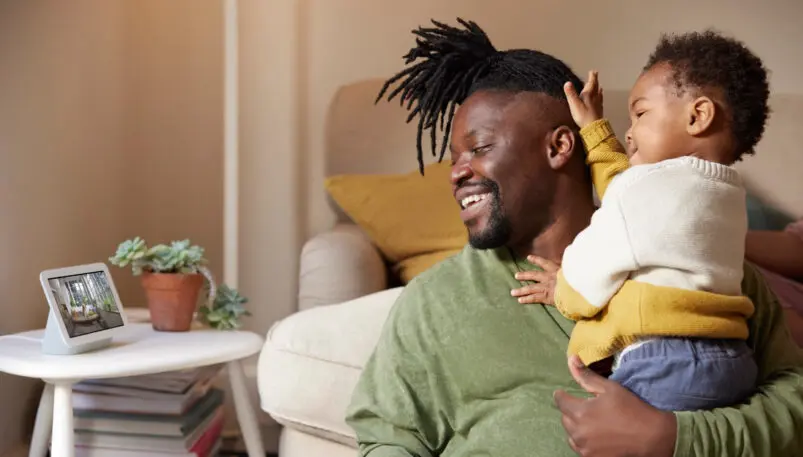Google is announcing a second edition of its Nest Hub smart screen. The most flashy upgrade? Sleep tracking.
The new Nest Hub will be available for preorder on March 16 and on shelves on March 30 for $100. It will come in four colors (chalk, charcoal, a bluey mist, and a reddish sand). Among the other updates will be a new machine-learning chip, so it can better remember your various gestures and favorite commands, and a third microphone, so it can hear you shouting across the room. And it will come with support for Thread, a protocol that will one day make Nest Hub interoperable with devices from Amazon, Apple, and other smart-home players. But today’s announcement is really about sleep.
The Nest Hub launched in 2018 as the Google Home Hub and was rebranded the following year. It’s tried to stand apart from competitors such as Amazon’s Echo Show and Facebook’s Portal by being ultra-useful. Its most beloved feature is that it can conjure recipes (and really any tutorial) on demand. In concert with other smart-home gadgets from Google and others, it can do all the basic things you expect from a home hub, such as control lights and show you video from your surveillance system.
But Google wanted to make it even more useful. In this update, the company added its Soli motion-tracking technology to the Nest Hub, giving it the ability to read gestures. (A creation of Google’s ATAP lab, the Soli technology debuted in 2019’s Pixel 4 phone.) Users will now be able to use gestures to halt an alarm or pause music. The technology is also the basis for the Hub’s new sleep feature.

Google product manager Ashton Udall says the Soli technology can detect big body movements and is capable of “sub-millimeter detection of movements like your chest moving in and out while you’re breathing.” Nest Hub also tracks coughing and snoring, and is equipped with a temperature gauge and an ambient light meter, so it can see how your environment changes while you sleep.
The company has taken care to ensure the Nest Hub tracks only you, even if you share your bed. During the setup process, the sleep-tracking feature walks you through a sort of get-to-know you process, so it knows how you lie in your bed and what your breathing looks like.
Soli sleep sensing [Animation: courtesy of Google]In the morning, Nest Hub will show your personalized sleep data. It will also give you a full report of your sleeping habits every week and make recommendations for how you can better your sleep, like putting a moratorium on doomscrolling in the 30 minutes before you try to fall asleep. This also includes a proposed sleep schedule tailored to you. The recommendations have been designed in partnership with the American Academy of Sleep Medicine.
The main goal of the new sleep tech is to tell you whether you woke up in the middle of the night—and how often, and what may have disturbed you. Was the room too hot? Was the room too cold? Were you coughing? Do you snore? While some sleep-tracking apps promise more in-depth observations, including body temperature, heart rate, and even sleep stage, Nest Hub is a little more focused on externalities that may be affecting your sleep. The device can also input sleep data into Google Fit, where you can juxtapose all the data from your various health trackers to get a deeper look at what might be troubling your sleep.
But Google is up-front about the limitations of its approach. “This is not a polysomnogram at your bedside,” says Dr. Logan Schneider, a neurologist at Stanford Medicine who focuses on sleep science and is a consultant to Google. Polysomnography is the standard sleep test scientists use to better understand a patient’s sleep. It tracks brain waves, muscle movement, respiration, heart rate measurements, body movement and position, and snoring. What Google is tracking is more superficial, but can still help direct people on how to get a better night’s sleep. “Focusing on behaviors you need to get good sleep is really the emphasis here,” Schneider says.
Privacy in mind
Udall went out of his way to mention that Google is very conscious about how sensitive sleep data is and that the company wants to make sure people feel confident they are the ones in control of it. The sleep tracking feature is opt-in only: The Nest Hub will not start sleep tracking without explicit consent. Data analysis happens on the device, and only certain data—such as if you woke up at a moment when the room temperature was high—goes to the cloud. Udall says it’s very easy to delete your data, even if you want to erase just a single night.

Why would Google put sleep tech in its tabletop home hub? The company says a fifth of users put the device in their bedroom. Another reason: Wearable sleep trackers are apparently difficult to stick with. Udall says that when his company ran a survey it found that people who use sleep trackers forget to wear them, charge them, and check them. The company is hoping that by tracking sleep passively on a bedside table, users will at least be collecting data on their sleep habits more regularly.

With the new Nest Hub, sleep-tracking technology is baked into a device you might buy even if it didn’t have sleep technology. Here, sleep tracking is a bonus if you want it and not the main event. That may ultimately work to its advantage.
Recognize your brand’s excellence by applying to this year’s Brands That Matter Awards before the early-rate deadline, May 3.